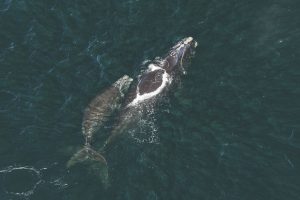
Wildlife
Our fascination with mammoths
How the legacy of these woolly giants persists in pop culture, storytelling, ecology and even the controversial idea of de-extinction
- 5019 words
- 21 minutes
Wildlife
Plus: The silver-haired bat that sings, the whale that lives in human-like clans, the industry that could breathe life into the Gulf of St. Lawrence, and the new regulations that aim to protect Canada's most valuable fish

One thousand kilometres through the White Mountains, from what is now western Yukon to Tanana Valley in central Alaksa, U.S.. That’s how far Élmayuujey’eh or “Elma” the woolly mammoth wandered, some 14,000 years ago for a period of about 2.5 years, according to a multidisciplinary team of Indigenous scholars and Canadian and American researchers.
The team used isotopic analysis of ancient DNA found in a female woolly mammoth’s tusk to determine the age and migration distance, sourced from Swan Point Archeological Site in Tanana Valley. The site is the earliest archeological site in Alaska, and is thought to have been a seasonal hunting camp used by early Alaskans. The presence of other mammoth remains, including those of a juvenile and a baby mammoth, suggests that mammoth herds also congregated there, according to the researchers. It’s therefore possible humans chose the site’s location for that reason.
Élmayuujey’eh was named by the Healy Lake (Alaska) Village Council, was about 20 years old when she died, and was closely related to other mammoths found at the site. Mammoths and humans are thought to have overlapped in Americas for at least 1,000 years — although a recent study by Indigenous archeologist Paulette Steeves suggests the timespan is likely much higher.

Take it away, little silver-haired bat! While all bats use clicks to echolocate prey and avoid running into things in the dark, singing is not in their usual repertoire.
But a new study in the Wildlife Society Bulletin has documented silver-haired bats in southern British Columbia tweeting, trilling and chirping through the treetops. “The song patterns were relatively consistent with each song phrase consisting of a lead call, followed by a droplet call, and finishing with a series of multiple chirp calls,” the study reads.
The next step is to try to figure out what prompts silver-haired bats to break into song. Is this the equivalent of bat crooning — a way to woo a mate? That’s the most likely reason, but researchers have also recorded a bat singing when it’s alone, leading them to wonder if it could be practising, or perhaps warning others to stay away.
“We don’t know if there is another bat a long way off that it’s trying to communicate (with) or is it just flying around singing to his little heart’s content trying to hopefully pick up a mate somewhere,” Cori Lausen, director of bat conservation with the Wildlife Conservation Society and one of the authors of the study, told the Canadian Press. Want to sing along? Listen in here.

Historians and scientists have long been fascinated by how our societies developed, how they were structured, and how they interacted with the natural world. What may come as a surprise are the similarities between how early humans lived and sperm whales now live: in structured clans.
Published in Royal Society Open Science, a new study out of Dalhousie University has examined how the behaviour of sperm whales showed strong similarities to human social associations, revealing a close parallel to how humans formed ethnolinguistic groups. According to the research paper, these sperm whale clans are determined by vocalizations involving distinct sequences of clicks. It also states that the clans can contain thousands of members and span thousands of kilometres. And although two or more clans may use the same waters, their members do not interact with each other.
The paper concludes that despite sperm whales being vastly different from humans, there are some broad-scale similarities, such as the large scale both humans and whales share in their numbers and geographical extent.

Green hydrogen energy production could have another environmental benefit — a steady supply of oxygen that could be added to increasingly hypoxic oceans and waterways.
A growing region of the Gulf of St. Lawrence and the St. Lawrence Estuary is currently under threat from decreased oxygen in subsurface waters, due in part to a climate-related reduction in the supply of oxygen-rich waters to the gulf through the Cabot Strait between Nova Scotia and Newfoundland. This could potentially lead to shifts in species distribution, reductions in fish stocks, and increased greenhouse gas emissions due to unusual algal blooms.
Now, in a new study, researchers from Dalhousie University are suggesting one way to stem the loss would be to actually pump oxygen back into these waters using a by-product of green hydrogen production. They’ve demonstrated that the proposed green hydrogen industry could produce more than enough oxygen regionally to match what is currently being lost from the Gulf of St. Lawrence every year. Typically, oxygen generated in the production of hydrogen would be released into the atmosphere, but this could instead be diverted into the Gulf’s waters to re-oxygenate the marine environment.

As elver harvesting season fast approaches, the Department of Fisheries and Oceans are weighing what new regulations could look like going forward. Elvers are a juvenile stage of American eel, as they grow from a tiny glass eel to leave the open ocean to enter estuaries and rivers. They are also Canada’s most valuable fish, fetching up to $5000 per kilo, with much of the demand coming from Asia, where the elvers are grown for consumption. The (authorized) fishery was worth $47 million in 2022. After an incredibly dramatic year last year, which saw tonnes of the baby eels being poached, “violent incidents and threats of violence” and harassment of fishery officers, DFO has recognized the need for new regulations.
Right now, while 12 elver fishing licences have been issued (three to First Nations), “there is no federal oversight or monitoring of the elver supply chain from harvest to export.” New regulations would require separate licences for possession and export of the baby eels and would aim to deter poaching and black-market shipments, as well as ensure safety and contribute toward the conservation of the American eel, the historical population of which has declined by 99 per cent in some areas. DFO is hoping to have the new regulations in place before the start of the 2024 harvesting season, which usually begins in March.
Are you passionate about Canadian geography?
You can support Canadian Geographic in 3 ways:

Wildlife
How the legacy of these woolly giants persists in pop culture, storytelling, ecology and even the controversial idea of de-extinction

Travel
An insider’s account of the modern-day gold rush

Wildlife
An estimated annual $175-billion business, the illegal trade in wildlife is the world’s fourth-largest criminal enterprise. It stands to radically alter the animal kingdom.

Wildlife
After a series of mass deaths in recent years, what can we do?